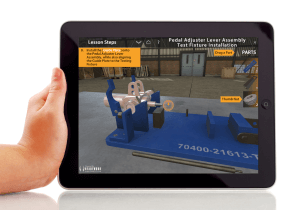How do you prepare technical training support in 20-30 languages? The answer: As much as possible, you DON’T. Instead, you need to transcend the language barrier. We’ll tell you how.
But first, let’s watch an astronaut (played by Matt Damon) deal with exactly this issue in the recent movie “The Martian,” see the first 30 seconds of the video below:
But what’s amusing in Hollywood can be deadly in real life. In industries where bad training puts safety at stake, language barriers MUST be overcome. So how do you get your point across?
Though the idea of offering training guides for every possible language (or at least the major ones) SEEMS like the right thing to do, attempting it is fraught with issues:
1. Nuances get lost in translation. Language is complex and it is easy to lose the precise meaning of a phrase if you are not a native speaker. And hard to catch if you’re depending on a translation service.
2. Misunderstandings can go unnoticed. Further, the non-native speaker may believe that he/she has clearly understood what is being communicated, when in fact they have missed a key point.
Moreover, the expense of translating training materials into multiple languages can be astronomical.
“In Europe, there are over 230 languages spoken and in Africa there are over 2,000 languages spoken, with variations in dialect causing different connotations even among areas that speak the same language.“
No company could afford to account for all of them, but which do you leave out? And what are the consequences of using translations deemed to be “close enough?”
In today’s global economy, if you are manufacturing and selling equipment, aircraft, or vehicles of any kind, chances are your product is going to be used or assembled by someone not native to your first language (in most cases, we mean NOT English).
“The single biggest problem in communication is the illusion that it has taken place.”
– George Bernard Shaw
Make Language Secondary – with VISUAL Communication
Communicating in a way that transcends language isn’t some abstract hope for the future. It happens every day: If you needed to teach someone who didn’t speak your language how to change a flat tire, how would you do it? You’d SHOW them how first, then use gestures to signal them to give it a try. And you’d provide feedback the same way – giving a thumbs up or thumbs down, for example.
It’s the same with training.
 To make training clear for everyone, language needs to take a back seat to solutions that are – Visual, Interactive, and Portable. This is where 3D Interactive Training really shines. Just like the example of the flat tire repair, 3D Simulation can:
To make training clear for everyone, language needs to take a back seat to solutions that are – Visual, Interactive, and Portable. This is where 3D Interactive Training really shines. Just like the example of the flat tire repair, 3D Simulation can:
1. SHOW you what to do (not TELL) in a virtual space that mimics the real thing
2. Let you PRACTICE on your own as often as necessary, safely – from anywhere
3. Give simple, intuitive, language-neutral FEEDBACK – thumbs up or down, green or red checkmarks, etc.
Language and text should be there for support, but they do not need to be the primary means of communicating the information – and they really shouldn’t be. Instead of reading a questionable translation, trainees can learn by doing – which is far more effective in any language.
Well-trained workers who are confident in their skills are more productive employees. Conversely, that confidence is hard to come by if they are unsure about what the training materials truly say (Like Matt Damon in the video!). Interactions between people without a language in common will increase in frequency, and you’ll either need to prepare or budget for an expensive game of catch up!
Heartwood’s 3D Interactive Training is designed to be a communication bridge to accommodate any language gap. Let us help you design a training roadmap that is not bound by the limitations of language. Reach out here to discuss the possibilities!
p.s. – for the necessary text portion that must be presented, our simulations can incorporate 20+ languages (and scripts).



